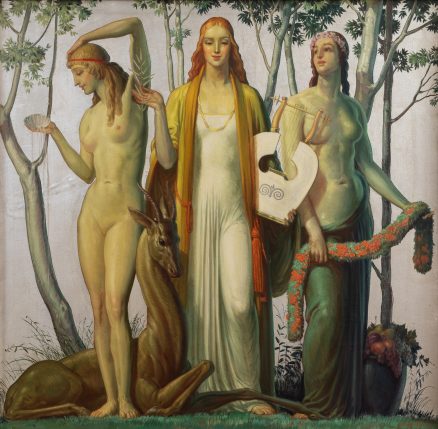- Categories
- Figural works
- Women
- Zoom in on Artwork
- Print Page
- Email Page to Friend
Louis Grell’s composition neatly balances the forms of three statuesque women against a backdrop of slender trees and grasses. Contrasting in pose, accoutrements, hair color, and degrees of undress, the women evoke allegorical personifications. The painting’s original title is unknown: it has been called The Three Muses, yet only the central figure can be identified with any of the nine Muses of ancient Greek mythology. She holds a lyre or cithara, an instrument associated with both Calliope, the Muse of epic poetry, and Erato, Muse of erotic or love poetry (Terpsichore, Muse of dance and choral music, is also often pictured holding a lyre, but usually seated); the olive branch she lifts delicately in her other hand is a traditional symbol of peace not usually associated with any muse, however. The nude woman on the left, holding a scallop shell from which water flows, may refer to Aphrodite or Venus, goddess of love and fertility; while the notion of plenty is suggested in the dark-haired figure on the right, proffering a blossoming garland and accompanied by a vessel laden with fruit. As graceful as the women is the recumbent antelope at their feet; this animal too cannot be identified with any particular meaning in Western iconography.
Grell’s painting is a reworking of a scene forming part of an elaborate ceiling decoration he created four years earlier in the lobby of the Gateway Theatre (now the Mitchell P. Kobelinski Theater in the Copernicus Center) in Chicago’s Jefferson Park neighborhood. Opened in 1930 to great fanfare, the Gateway was designed by Rapp and Rapp, a Chicago firm renowned for its designs for movie palaces; built across the nation, they were mostly decorated by Grell. The geometric emphasis of the Gateway’s flattened, stylized ornamental decoration exemplifies the Art Deco style. For this composition, Grell made significant changes from the ceiling painting. Here the suggestion of a landscape background has been substituted for an Art Deco-style jagged halo around the figures, and the one on the right holds a garland rather than attributes signifying the performing arts. Yet the sleek, elongated forms of the women and the taut musculature of the antelope, the rigid balancing of forms in the almost-square composition, and the delicate patterning of foliage in the background are among the features that stamp this work with the Art Deco-inflected classicism that was the height of fashion in the early 1930s, an era obsessed with glamor in the midst of economic depression.
How the figures should be interpreted, the reasons for the particular changes from the Gateway Theatre image, and the original use or placement of this painting all are unknown. With its pseudo-allegorical content and facile illustrational style, it may have been intended as a contributing element in a larger coordinated decorative program rather than as a stand-alone work of art. The firmly articulated surfaces and emphatically dimensional modeling of the figures evince Grell’s early training in Germany; the flattened composition and frieze-like arrangement of forms reflect his abundant experience in designing painted decorations for large-scale interiors.
Wendy Greenhouse, PhD
Donated by M. Christine Schwartz to Iowa Western Community College, Council Bluffs, Iowa, in 2023
